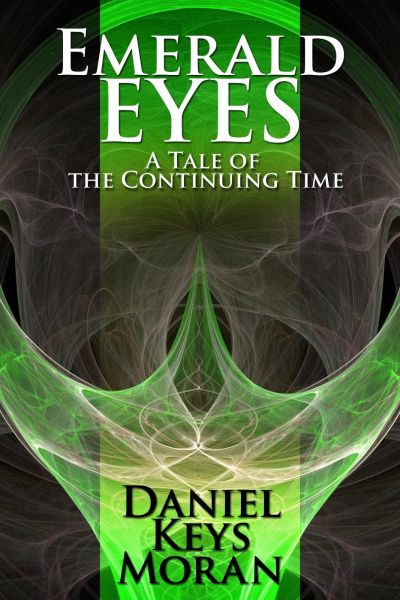It’s black helicopter time
Emerald Eyes (Tales of the Continuing Time, volume 1)
By Daniel Keys Moran

15 Dec, 2015
0 comments
1988’s Emerald Eyes is the first volume in Daniel Keys Moran’s Tales of the Continuing Time. It was also, I believe, his second novel, published three months after Armageddon Blues and three months before The Ring. 1988 was a very busy year for Mr. Moran.
21st Century America is an occupied nation. A restive occupied nation, as many of its people are fundamentally incapable of adjusting to life under the victorious French-dominated United Nations — no matter how remorselessly the Peacekeepers stomp on stiff American necks. Few Americans have it harder than Carl Castanaveras, because he and the rest of his family are not merely subjugated by the UN.
They are property.
Inexplicable product of a genetic engineering project that otherwise produced nothing of value, Carl is a telepath, the first of a line that the omniscient narrator, Named Storyteller, assures us will eventually give rise to the House of November. The House of November may be fated to be genetic aristocrats (eventually) but first-generation Carl and his legion of children are simply tools that the UN uses to maintain control over overpopulated Earth. They also serve as the raw material in ill-considered experiments.
Years of legal effort pay off: the Castanaveras telepaths are been recognized as humans with all the rights of humans (as are the quasi-feline de Nostri). Carl and the rest of the Castanaveras telepaths will gain the right to work for whom they choose. This is an affront to UN officials like Jerril Carson, who is unwilling to give up a valuable possession and even more unwilling to see the telepaths’ gifts in private use.
To make matters worse, Jerril and Carl loathe each other. Carl once lashed out at Jerril, protesting some ill-considered research that killed Carl’s friend Shana de Nostri. Carl and his clan may be telepaths, they may have the law on their side, but Jerril and his allies have power and the ability to escalate all the way up to thermonuclear weapons.
~oOo~
Named Storyteller is a story teller who is actually named Named Storyteller. He’s a time traveler who worked behind the scenes to create Carl and his gifts (because the UN was technologically incapable of producing Carl when Storyteller’s history said he happened; intervention was necessary to save history).
The UN in this story has bought into the Population Bomb model according to which Malthusian Doom can only be averted through heavy-handed government intervention. That sort of thing was popular at the time the book was written, even though it has since become apparent that more benign methods (educating women, for one) work far better. It also seems to have been a panicked response the famines that plague the 21st century, which the book shows to be less due to overpopulation and more due to the UN’s clumsy forays into weather control, which have caused crippling droughts.
The UN was led by do-gooders when it first conquered the world, but the sincere ideologues have since been replaced by people more interested in their own well-being. The do-gooders killed millions in the course of their conquest, and their policies have arguably killed billions over the course of the 21st century. The self-serving sociopaths now running the UN may seem less threatening but given how quickly they resort to using nukes on restive cities I suspect their body count may go much, much higher.
You can guess why the sociopaths find telepaths threatening. Given Carl’s seething rage over how he and the other genetically engineered people have been treated, a happy resolution to the conflict seems unlikely.
For reasons of convenience I read the ebook edition of this novel, but I do have the mass market paperback from the 1980s. The dedication to the recent ebook edition reads:
Amy Stout-Moran. She was the editor at Bantam Books who first bought this novel; she is the mother of my sons and the love of my life.
The original was dedicated to Poul Anderson, Isaac Asimov, Ronald J. Bass, Marion Zimmer Bradley, Robert Heinlein, Steven King, John D. MacDonald, Gregory McDonald, Larry Niven, Tom Robbins, E.E. “Doc” Smith, Mary Stewart, Theodore Sturgeon, Hunter S. Thompson and J.R.R. Tolkien, followed by another dedication to Sturgeon, Eager, Alexander, Nesbit, L’Engle, Cooper, Engdahl, Tolkien and C.S. Lewis, and a third dedication to Moran’s father.
The sprawling scope of the original dedication is a hint that the following book would be enthusiastic, energetic, and undisciplined. Moran clearly feels that he has invented a marvelous, convincing future world, a vast setting he does his level best to cram into a fairly short novel. I don’t remember if I’ve ever compared this book to a hummingbird on speed (I have some vague memory of doing so), but if I didn’t, I will now. The result may be very hyperactive, but it is definitely engaging.
Emerald Eyes can be purchased here.
